Chapter Outline
3.1 Animal Tissues
3.2 Epithelial Tissue
3.3 Connective Tissue
3.4 Muscle Tissue
3.5 Neural Tissue
Learning Objectives:
• Recognises the types of tissues based on their characteristic features
• Understands the description, location, functions and modification of tissues.
• Understands the significance of muscles, connective and neural tissues.
In multicellular organisms, cells do not operate independently, instead, they form tight cell communities that live and work together. Individual body cells are specialized, with each type performing specifi c functions that helps to maintain homeostasis and benefi ts the body as a whole. Cell specialization is obvious. How the muscle cell looks and acts diff ers greatly from skin cells. Cell specialization allows the body to function in co-ordinated ways.
Groups of cells that are similar in structure and perform common or related functions are called ‘tissues’.
Tissues are organized in specific proportions and patterns to form organs like lungs, heart, stomach, kidneys, ovaries, testes etc; hence the tissues are called the ‘living fabrics’. If two or more organs perform common physical and chemical functions they are called ‘organ systems’, Eg: digestive system, respiratory system, circulatory system, excretory system, etc. Most organs contain different types of tissues and their arrangement determines the organ’s structure and functions. The study of tissues, or histology, complements the study of gross anatomy. Together they provide the structural basis for understanding organ physiology.
3.1. Animal Tissues
Animal tissues are classifi ed according to the size, shape and function of the cells. There
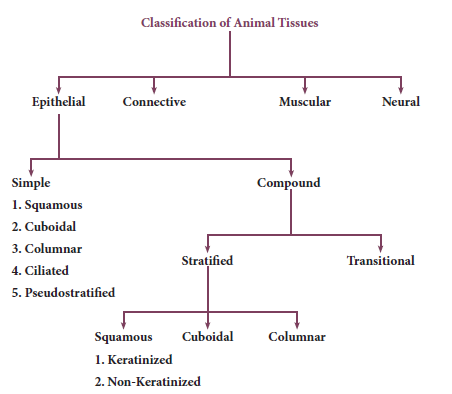
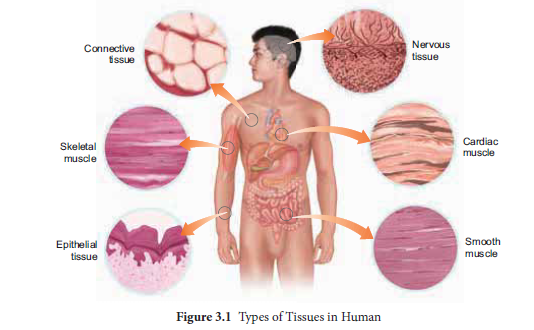
are four primary (basic) tissue types that interweave to form the ‘fabric’ of the body.They are, the epithelial tissue (covering),the connective tissue (support), the muscle tissue (movement) and the nervous tissue (control) (Figure 3.1).
3.2 Epithelial Tissue
Epithelial tissue is a sheet of cells that covers the body surface or lines the body cavity. It occurs in the body as a covering, as a lining epithelium and as glandular,epithelium. The functions of epithelium includes protection, absorption, filtration,excretion, secretion and sensory reception.Based on the structural modification of the cells, the epithelial tissues are classified into simple epithelium and compound epithelium or stratified epithelium.
Simple epithelium is composed of a single layer of cells. They are found in the organs of absorption, secretion and filtration. Simple epithelial tissue is further classified into squamous epithelium,cuboidal epithelium, columnar epithelium, ciliated epithelium and pseudostratified epithelium (Figure 3.2). The squamous epithelium is made of a single thin layer of flattened cells with irregular boundaries.They are found in the kidney glomeruli, air sacs of lungs, lining of heart, blood vessels and lymphatic vessels and are involved in functions like forming a diffusion boundary and filtration in sites where protection is not important. The cuboidal epithelium is made of a single layer of cube like cells. This tissue is commonly found in the kidney tubules, ducts and secretory portions of small glands
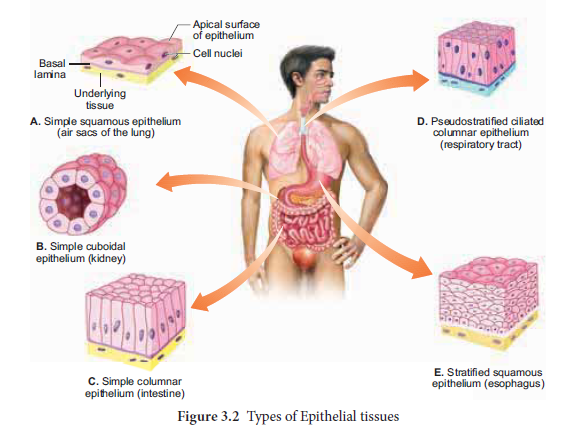
and surface of the ovary. Its main functions are secretion and absorption. The columnar epithelium is composed of single layer of tall cells with round to oval nuclei at the base. It lines the digestive tract from the stomach to
the rectum. The two modifications of this lining are the presence of microvilli on the apical surface of the absorptive cells and Goblet cell which secretes the protective lubricating mucus. The functions of this epithelium include absorption, secretion of mucus, enzymes and other substances. If the columnar cells bear cilia on their free surfaces they are called ciliated epithelium.This ciliated type propels mucus by ciliary actions and it lines the small bronchioles,fallopian tubes and uterus. Nonciliated type lines most of the digestive tract, gall bladder and secretory ducts of glands.Pseudo-stratified epithelial cells are columnar, but unequal in size. Although the epithelium is single layered yet it appears to be multi-layered because the nuclei lie at different levels in different cells. Hence, it is also called pseudostratified epithelium and its functions are protection, secretion and absorption. Ciliated forms line the trachea and the upper respiratory tract. The non ciliated forms, line the epididymis, large ducts of a glands and tracts of male urethra
Important epithelial tissue disorders:Eczema, Psoriasis, Epithelial carcinoma and severe asthma
Some of the cuboidal or columnar cells get specialized for secretion and are called glandular epithelium (Figure 3.3). They are mainly of two types: unicellular, consisting of isolated glandular cells (goblet cells of the alimentary canal), and multicellular, consisting of cluster of cells (salivary gland).On the basis of the mode of pouring of their secretions, glands are divided into two categories namely exocrine and endocrine glands. Exocrine glands secrete mucus, saliva, earwax, oil, milk, digestive enzymes and other cell products. These products are released
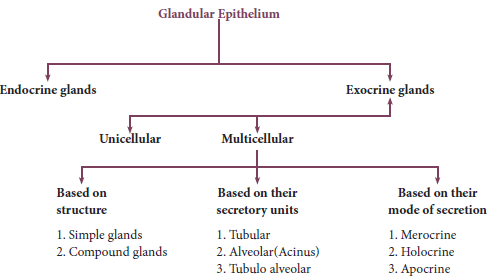
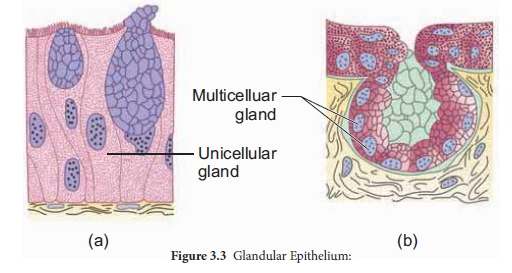
glands do not have ducts. Their secretions called hormones are secreted directly into the fluid bathing the gland. The exocrine glands are classified as unicellular and multicelluar glands. The multicelluar glands are further classified based on the structure as simple and compound glands, based on their secretory units as tubular, alveolar (Acinus) and tubulo alveolar. Based on the mode of secretion exocrine glands are classified as merocrine, holocrine and apocrine.

